Many seniors hope to retain their independence as much as possible as they age, and continuing to live at home is a top priority for some. But living alone into old age can put seniors at risk of injuries or other emergencies. According to the CDC, 25% of adults fall each year, and 1 out of 5 of those falls cause serious injuries like a broken bone or head trauma. If you have an aging loved one who lives alone, you’ve probably experienced anxiety and concern that a fall or other accident may occur and they will have no one there to help them.
While there is no way to entirely prevent serious incidents or emergencies, there are things you can do to make sure that your loved one will get the help that they need when an emergency does occur. Medical alert systems can be an invaluable resource in this regard.
Medical alert systems are great for those who want the security of around-the-clock emergency assistance for yourself or a loved one who has chosen to live independently and/or age in place. The devices allow seniors to retain their independence and live in their preferred environment, without the major risk of them being without help if and when they need it.
Choosing between the many companies that sell medical alert systems and the different styles of devices they offer can be overwhelming. It’s often hard to determine which companies are genuine and reliable and which ones may be overpriced or trying to surprise customers with hidden fees. This guide will help you learn about medical alert companies and devices so you can make an informed decision and find a medical alert system that is the best fit for yourself or a loved one.
What to Look For in a Home Medical Alert Company
- Transparency: Companies should be upfront about their pricing. Avoid companies with hidden fees or those who use misleading sales tactics.
- No Long Contracts: Some companies have contracts that last up to 3 years, and breaking the contract can result in a steep fee. Make sure you can cancel your service at any time without paying a cancellation penalty.
- Customer Service: If a company is hard to get a hold of or not good at communicating, you may want to think twice about relying on its emergency services.
- Comfortable and Durable Devices: If you are purchasing a mobile device, bulky all-in-one units may not be comfortable and can make the user feel less inclined to actually wear the device. Make sure the device is comfortable to wear or carry around all day. You’ll also want a device that can withstand normal wear-and-tear and is water resistant.
- Protection in the Shower: Bathrooms present a high-fall risk for many seniors due to the slick, hard surfaces and potential for water to create hazards. Look for waterproof pendants or other solutions that ensure you or your loved one will be protected in the bathroom.
- Caregiver Monitoring: Not all caregiver monitoring apps are created equal. Beyond checking if a company offers such a feature, look for services like activity tracking and device location services.
The 14 Best Medical Alert System Companies
| Lowest In-Home Cost | Lowest Mobile Cost | Starting Fees | |
| MobileHelp | $19.95 | $37.95 | $15.00 – $49.95 |
| Bay Alarm Medical | $19.95 | $24.95 | $9.95 – $79.99 |
| Medical Guardian | $29.95 | $39.95 | $9.50 – $108.50 |
| Medical Care Alert | $29.95 | $39.95 | $12 |
| LifeStation | $19.95 | $34.95 | $50 |
| Philips Lifeline | $29.95 | $49.95 | $69.95 – $249 |
| ResponseNow | $29.95 | $39.95 | $14.95 – $49.95 |
| GreatCall Lively Mobile | N/A | $24.95 | $94.99 |
| RescueTouch | N/A | $30 | $99 – $178 |
| LifeFone | $29.95 | $39.95 | $0 |
| Rescue Alert | $32.95 | $44.95 | $0 |
| Alert1 | $28.95 | $45.95 | $0 |
| QMedic | $30 | $45 | $0 |
| Life Alert | $49 | $89 | $95 – $198 |
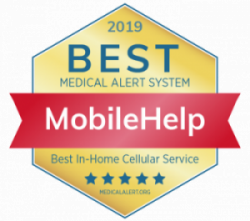
MobileHelp
Most Affordable In-Home Cellular System
Seniors without a landline in their homes should pay special attention to extra charges for in-home cellular systems. Some companies may seem to offer in-home coverage at a low cost, but many add an extra fee for cellular connection instead of a landline. For those who do not have a landline, this extra monthly fee can take a medical alert system from in-budget to prohibitively expensive.
Unlike many other companies, MobileHelp does not charge an extra fee for its in-home cellular system, the MobileHelp Classic. That means that the monthly price you see listed for the Classic is the price you pay. Given that the Classic is one of the least expensive in-home options offered by any top medical alert company, MobileHelp is a great choice for seniors who do not have a landline and are looking to keep costs low.
Pricing and Plans
MobileHelp customers can choose to pay for their devices on a monthly, quarterly, semi-annual, or annual basis. The exception is the Touch device, which is only available with semi-annual and annual payment options. The plans range in price from $19.95 a month for the Classic device to $59.45 for the Touch, which includes a mobile system, in-home wearable help button, and a tablet device. Quarterly, semi-annual, and annual payment plans include free shipping, but those who opt for the monthly plans will pay $15.00 for ground shipping. Longer-term service plans also save customers a few dollars per month compared to the monthly plan.
The Solo and Duo systems do not have activation or shipping fees, but those who pay monthly for the Classic device must pay a one-time fee of $49.95.
There are no long-term contracts, and users may cancel their service at any time and receive a prorated refund on any prepaid months. MobileHelp also offers a 30-day free trial for all new users, during which they can return their device for a full refund.
| Classic | Wired Home | Solo | MobileHelp Duo | Mobile Duo | Touch | |
| Monthly Cost | $19.95 | $24.95 | $37.95 | $41.95 | $44.95 | $59.45** |
| One-time Fees | $49.95 | N/A | N/A | N/A | N/A | N/A |
| Type of Device | In-home system | In-home system | Mobile system | In-home and mobile system | Mobile | In-home, mobile, and tablet |
| Connection | Cellular | Landline | Cellular | Cellular | Cellular | Cellular |
| Battery Life | 30-hour backup | 30-hour backup | 24 hours | 24 hours; 30-hour backup | 24 hours | 24 hours; 12-hour backup for tablet |
| Water Resistant | Yes | Yes | Yes | Yes | Yes | Yes*** |
| Shower-proof | Yes | Yes | Yes | Yes | Yes | Yes*** |
| Range | 600 feet | 1,300 feet | N/A | 600 feet | N/A | 150-350 feet |
| Fall Detection | $10 a month | Not available | $10 a month | $10 a month | $10 a month | $10 a month |
**6-month minimum payment period
***The tablet and portable device are not waterproof
MobileHelp Classic
Read MoreMobileHelp Wired Home
Read MoreMobileHelp Solo
Read MoreMobileHelp Duo
Read MoreMobile Duo
Read MoreTouch
Read MoreMonitoring
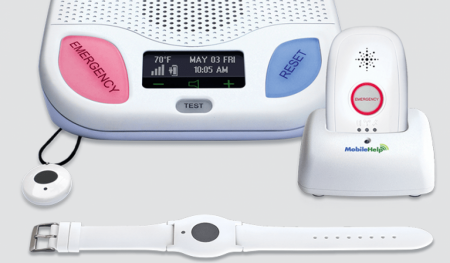
MobileHelp devices are monitored by Rapid Response, a third-party US-based monitoring company. Rapid Response is a member of The Monitoring Association (TMA), and all of its operators are certified by the Security Industry Association.
Extra Features
Extra accessories that MobileHelp customers can add to their subscription plan include:
- Wall Mounted Help Button: Customers can add this extra button to their subscription plan for an additional $2 a month
- Medication Reminders: Customizable medication reminders can be added for $5 a month. Users can schedule the medication reminders online, and MobileHelp will send reminders through the base station unit.
- Lockbox: MobileHelp currently provides all customers with a lockbox free of charge. The lockbox allows EMS to enter your home during an emergency if you are unable to answer the door.
- Jewelry Pendants: MobileHelp offers colorful jewelry pendants for customers who would prefer to wear a stylish, bejeweled necklace rather than the traditional medical alert pendant. Jewelry pendants are currently available in four different metal and jewel options and range in cost from $69.95-$79.95.
For more, read our full review of MobileHelp’s medical alert systems
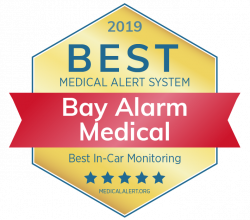
Bay Alarm Medical
Best for On-the-Road Monitoring
Bay Alarm Medical offers a unique in-car device that is ideal for drivers. The device has a personal help button that connects drivers to the emergency monitoring center, as well as GPS location tracking and crash detection that automatically signals emergency services if a crash occurs. Family members and caregivers of users can also view their loved one’s location and driving routes via a mobile app.
Pricing and Plans
Bay Alarm Medical offers monthly and semi-annual payment options for its five systems. The systems range in price from $19.95 a month for the in-home landline system to $69.95 a month for the most comprehensive, bundle option. There is no discount for paying on a quarterly or semi-annual basis, but those who choose the semi-annual plan receive free shipping, which typically costs $9.95. The On the Go device must be purchased for a one-time fee of $79.99, but no other Bay Alarm Medical devices have any one-time fees. Customers can cancel their service at any time without paying penalty, and those who return their devices within 30 days receive a full refund.
| In-Home (Landline) | In-Home (Cellular) | On the Go | On the Road | Full Coverage |
|
| Monthly Cost | $19.95 | $29.95 | $24.95 | $29.95 | $59.95 |
| One-time fees | N/A | N/A | $79.99 | N/A | $79 |
| Type of Device | In-home system | In-home system | Mobile system | In-car system | In-home and mobile system |
| Connection | Landline | Cellular | Cellular | Cellular | Landline/Cellular |
| Battery Life | 32-hour backup | 32-hour backup | 3 days | N/A | 32-hour backup; 3-day mobile battery |
| Water Resistant | Yes | Yes | Yes | N/A | Yes (other than On the Road) |
| Shower-proof | Yes | Yes | Yes | N/A | Yes (other than On the Road) |
| Range | 1,000 feet | 1,000 feet | N/A | N/A | 1,000 feet |
| Fall Detection | $10 a month | $10 a month | $10 a month | N/A* | $10 a month |
*Automatic crash detection is included
In-Home
Read MoreOn the Go
Read MoreOn the Road
Read MoreFull Coverage Package
Read MoreMonitoring
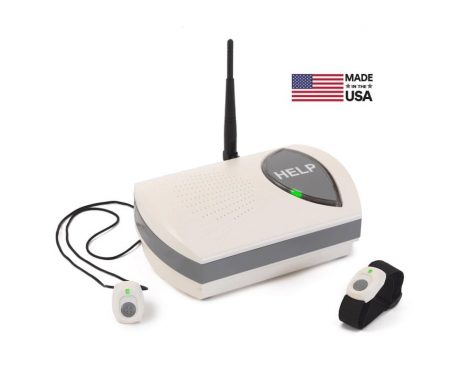
Bay Alarm Medical partners with a US-based monitoring center with locations in Utah and Idaho. Both centers are CSAA Five Diamond Certified.
Extra Features
Bay Alarm Medical offers several extra features, including:
- Lockbox: Lockboxes provide EMS with an easy way to enter users’ homes during an emergency. One can be added to a monthly plan for $1.95 a month
- Wall Buttons: This is an additional help button that can be wall mounted around the home for extra protection. The button costs $2.95 a month, or $10 for a pack of four.
- Designer Pendants: Users whose devices have a lanyard option can choose to upgrade to colorful, artistic designer pendants for a one-time fee of $27.95.
For more, read our full review of Bay Alarm Medical’s medical alert systems
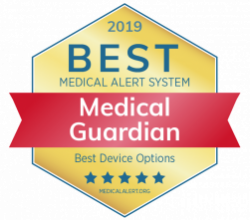
Medical Guardian
Best Customer Service
Medical Guardian’s devices do more than just provide emergency monitoring services. Several of their systems come with activity tracking and a caregiver mobile app, and they are the only company to offer voice-activated wall buttons for extra in-home protection. Plus, Medical Guardian puts a heavy emphasis on customer experience and strives to meet all of its customers needs starting from the shopping process, to providing quality emergency support, to consumer-friendly refund and cancellation policies. When purchasing a medical alert system, you’re entrusting your safety or that of your loved one with the provider that you choose. With Medical Guardian, you can rest assured that the company will put your needs first.
Pricing and Plans
Medical Guardian’s offerings include six different devices, all which can be paid for on a monthly, quarterly, or annual basis. The plans in range price from $29.95 a month to $79.95 a month. The smartwatch-style device also comes with a one-time equipment cost of $99, but no other Medical Guardian devices have an activation or device fee.
Those who opt for the annual plans save a few dollars per month. Annual customers also receive free shipping when they order the device; other customers have to pay $9.50 for standard shipping. While free shipping is not included, there are no cancellation fees, and Medical Guardian will provide prorated refunds for any months that were prepaid at the time of cancellation. There are no long-term contracts, even for those who pay for their service quarterly or annually.
| Classic Guardian | Home Guardian | Family Guardian | Mobile Guardian | Active Guardian | Freedom Guardian | |
| Monthly Cost | $29.95 | $34.95 | $79.95 | $49.95 | $44.95 | $44.95 |
| One-time Fees | N/A | N/A | N/A | N/A | N/A | $99.00 |
| Type of Device | In-Home Only | In-Home Only | In-Home Only | Mobile | Mobile | Smartwatch-style device |
| Connection | Landline | Cellular | Cellular | Cellular | Cellular | Cellular |
| Battery Life | 32-hour backup | 30-hour backup | 32-hour backup | 24 hours | 5 days | 2 days |
| Water Resistant | Yes | Yes | Yes | Yes | Yes | No |
| Shower-Proof | Yes | Yes | Yes | Yes | Yes | No |
| Range | 1,300 feet | 600 feet | 1,300 feet | Unlimited | Unlimited | Unlimited |
| Fall Detection | $10 a month | $10 a month | $10 a month | $10 a month | $10 a month | Not Available |
Classic Guardian
Read MoreHome Guardian
Read MoreFamily Guardian
Read MoreMobile Guardian
Read MoreActive Guardian
Read MoreFreedom Guardian
Read MoreMonitoring
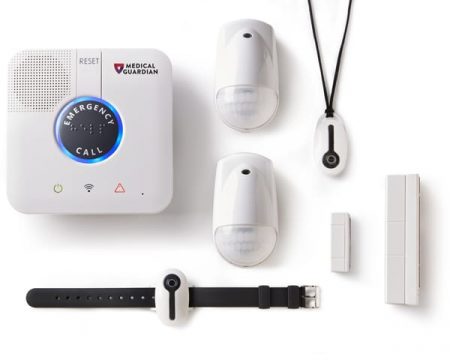
Medical Guardian devices are monitored by a third-party service. The 100% US-based monitoring service is UL listed, certified by The Monitoring Association (TMA), and a member of the Electronic Security Association. Additionally, many users have noted the fast response times for Medical Guardian devices.
Extra Features
Medical Guardian customers have the option of adding several extra features to their monthly plan:
- Mounted Wall Button: The mounted wall button can be placed anywhere in the home and adds extra protection in high-risk areas. If a senior needs help and they aren’t wearing their pendant, they can signal the monitoring center via the wall-mounted button instead. The button costs an extra $2.99 a month and is available with in-home and mobile device options.
- Voice Activated Wall Button: Like the wall-mounted button, the voice-activated button provides extra protection anywhere in the home. Rather than pressing the button, the user simply has to say “call Medical Guardian” twice to trigger a call to the monitoring center. This add-on costs an additional $5 a month, and is only available with the Classic Guardian and Family Guardian plans.
- Lockbox: All customers have the option of adding a lockbox for $2 a month (those who sign up for an annual subscription receive a lockbox free of charge). A lockbox allows emergency services to easily enter your home without causing damage if you are unable to answer the door.
- Additional Help Buttons: For $3.99 per button, users can add up to three extra help buttons to their monthly service plan. Seniors have the choice of a wristband, pendant, and/or wall-mounted button for their extra button.
For more, read our full review of Medical Guardian’s medical alert systems
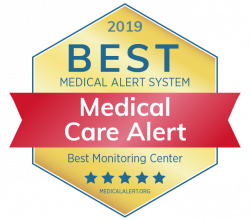
Medical Care Alert
Best for Experienced Monitoring Centers
Medical Care Alert’s monitoring centers are staffed by some of the most experienced operators in the industry. All operators are EMT/EMD certified, and undergo a six-week training program certified by the Security Industry Association.
When users call the emergency monitoring center, it triggers an automatic SMS alert to the user’s list of preferred contacts such as family, friends, or a caregiver to let them know that there is an emergency. This ensures users’ loved ones know right away if their loved one needs assistance.
Pricing and Plans
Medical Care Alert customers have four devices to choose from, ranging in price from $29.95 to $39.95 a month. New customers can choose between paying for their system on a quarterly, semi-annual, or annual subscription. All customers must complete one initial subscription period (i.e., one quarter) before they can switch to month-to-month pricing. If they choose to do so, the monthly cost is the same as the quarterly plan. The annual subscription saves customers a few dollars per month.
There are no initial one-time fees, but shipping is not included and typically costs about $12. There is a 14-day trial period during which new customers can try any of the systems free of cost. Users may cancel their service at any time without penalty, and will receive a prorated refund for any prepaid months.
| HOME System | HOME-3G System (Cellular) | HOME & YARD | HOME & AWAY ULTRA | |
| Monthly Cost | $29.95 | $34.95 | $34.95 | $39.95 |
| One-time Fees | N/A | N/A | N/A | N/A |
| Type of Device | In-home system | In-home system | In-home system | Mobile system |
| Connection | Landline | Cellular | Landline | Cellular |
| Battery Life | 72-hour backup | 72-hour backup | 24-hour backup | 3 days |
| Water Resistant | Yes | Yes | Yes | Yes |
| Shower-proof | Yes | Yes | Yes | Yes |
| Range | 1,000 feet | 1,000 feet | 600 feet | N/A |
| Fall Detection | $10 a month | $10 a month | Not available | $10 a month |
HOME System
Read MoreHOME-3G System
Read MoreHOME & YARD
Read MoreHOME & AWAY ULTRA
Read MoreMonitoring
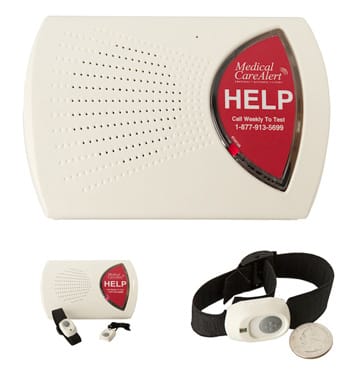
Medical Care Alert operates its own monitoring centers with locations in New York and California. The centers are fully staffed by EMT/EMD certified operators, and is Security Industry Association certified. Spanish-speaking operators are on duty at all times.
Extra Features
Customers can choose to purchase additional accessories, including:
- Lockbox: Lockboxes are available for purchase for $29.95. They are included free of charge with all annual plans, and certain semi-annual and quarterly plans.
- Wall Mounted Button: These buttons can be placed anywhere around the home where users want extra protection. They have a range of 1,000 feet from the base station and function as an extra help button. HOME and HOME-3G users can opt to have one of their two included personal help buttons replaced with a wall mounted button. Otherwise, they can be purchased for $29.95.
For more, read our full review of Medical Care Alert’s medical alert systems
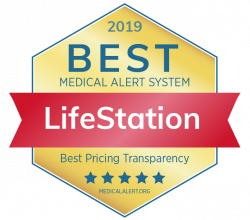
LifeStation
Best for Comprehensive Service Plans
LifeStation’s prices are based on service packages. For each of its three devices, customers choose between a Standard, Select, or Supreme package. The Standard is a basic monitoring package, the Select includes either fall detection or a device protection plan, and the Supreme includes both fall detection and device protection, along with some free accessories. The package system makes it easy for customers to access these extra features without having to worry about paying for each thing individually.
Pricing and Plans
LifeStation offers three devices that range in price from $19.95 a month to $34.95 a month with a Standard service plan. Customers may also choose a Select or Supreme package, which are more expensive but come with added features. Select plans come with either fall detection or a device protection plan, and Supreme packages include both.
Free shipping is included with all devices, and there are no one-time costs other than a $50 activation fee for the Mobile with GPS Standard package. All customers have a 30-day trial window during which they can return the equipment for a full refund, although they may have to pay return shipping.
| In-Home Traditional | In-Home Plus | Mobile LTE | |
| Monthly Cost | $19.95 | $26.95 | $34.95 |
| One-time Fees | N/A | N/A | $50* |
| Type of Device | In-home system | In-home system | Mobile system |
| Connection | Landline | Cellular | Cellular |
| Battery Life | 48-hour backup | 48-hour backup | 5 days |
| Water Resistant | Yes | Yes | Yes |
| Shower-proof | Yes | Yes | Yes |
| Range | 650 feet | 650 feet | N/A |
| Fall Detection | $5 a month | $5 a month | $5 a month |
*$50 device fee only applies to the Standard service package
In-Home Traditional
Read MoreIn-Home Plus
Read MoreMobile LTE
Read MoreMonitoring
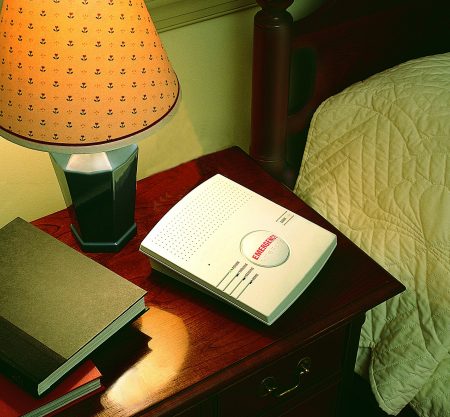
LifeStation uses its own monitoring centers with locations in New Jersey and Texas. The centers are UL-listed and CSAA Five Diamond certified
Extra Features
LifeStation offers the following accessories for purchase:
- Users can lease a lockbox from Lifestation for $2.99 a month. The lockbox makes it easy for EMS to enter users’ homes during an emergency if they are unable to answer the door.
- Mountable help buttons to provide extra protection around the home are available for $2.49 a month.
- Customers can purchase an additional personal help button that allows another user to use the system for $3.99 a month.
For more, read our full review of LifeStation’s medical alert systems
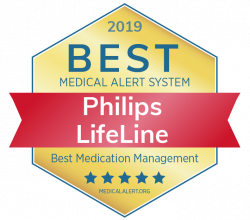
Philips Lifeline
Best Medication Management System
Philips Lifeline helps simplify complex medication regimens with their automatic medication dispenser. The dispenser allows users to program their medication schedules, so they receive an alert when it is time to take their medication and can automatically dispense the proper medication and dose with the press of a button. It can hold up to 60 cups of medicine, and also alerts the user and/or their loved ones or caregiver when a dose is missed or it’s time to refill the device.
Pricing and Plans
Philips Lifeline offers four devices that range in price from $29.95 to $54.95 a month. There are no quarterly, semi-annual, or annual payment discounts. All of the devices have a one-time fee, ranging from $50 for the HomeSafe systems to $149 for the GoSafe. Shipping is not included and costs $19.95. If customers wish to have a technician come to their home and install the device, they must pay $100 (this replaces the shipping cost).
There is no trial period, but customers who return their device within 30 days are eligible for a refund. However, the one-time activation and equipment fees are not refundable.
| HomeSafe | HomeSafe with AutoAlert | GoSafe 2 | GoSafe | |
| Monthly Cost | $29.95* | $44.95* | $49.95 | $54.95** |
| One-time fees | $50 | $50 | $99.95 | $149 |
| Type of Device | In-home system | In-home system | Mobile system | In-home and mobile system |
| Connection | Landline or Cellular | Landline or Cellular | Cellular | Landline or Cellular |
| Battery Life | 48-hour backup | 48-hour backup | 2-3 days | 7 days; 48-hour backup |
| Water Resistant | Yes | Yes | Yes | Yes |
| Shower-proof | Yes | Yes | Yes | Yes |
| Range | 500 feet | 500 feet | N/A | N/A |
| Fall Detection | Not available | Included | Included | Included |
*The cellular model costs an extra $14 a month
**The cellular model costs an extra $15 a month
HomeSafe
Read MoreGoSafe
Read MoreGoSafe 2
Read MoreMonitoring
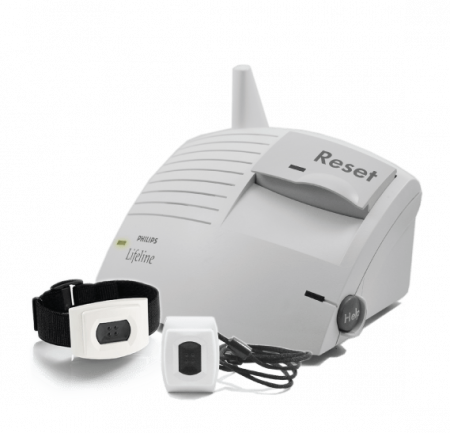
Philips Lifeline has its own in-house monitoring center, referred to as the Response Center. There are Response Centers located in the U.S. and Canada. The associates undergo 80 hours of training, and can support users in over 140 languages.
Extra Features
Philips Lifeline offers a unique automated medication dispensing system for $59.95 a month (plus a one-time installation fee of $99). The system allows seniors to program their medication schedules so the system plays a reminder when it is time for a dose, and dispenses the appropriate medication with the push of a button. This helps reduce the risk of missing a dose or taking the wrong medication, which can cause serious medical problems.
Other features that Philips Lifeline offers include:
- A voice extension base that expands the range of in-home systems. The base is an additional $10 a month.
- A lockbox can be purchased for a one-time fee of $29.95.
For more, read our full review of Philips Lifeline’s medical alert systems
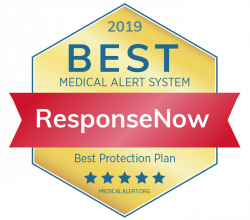
ResponseNow
Best Device Repair and Protection Plan
All ResponseNow customers may add the Care(+) Protection Plan to their subscription for $3.95 a month. The protection plan offers extra coverage for equipment repairs or damage, and covers the cost of any necessary service. This includes accidental damage from dropping the device or spilling a beverage on the base unit, as well as theft and even loss. For those who do not opt to purchase the Care(+) Protection, ResponseNow still covers repairs for faulty equipment and provides services like battery replacement free of charge.
Pricing and Plans
ResponseNow offers three devices ranging in price from $29.95 to $49.95 a month. All devices may be paid for on a monthly, quarterly, or annual basis. Choosing the quarterly or monthly option reduces the cost by a few dollars per month, and includes free shipping. Those who choose the monthly plan must pay $14.95 for ground shipping.
The Belle and Belle+ devices have a one-time fee of $35. There are no one-time fees for the in-home device. All devices come with a 30-day trial period during which customers can return their device for a full refund. There are no cancellation fees.
| In the Home | Belle | Belle+ | |
| Monthly Cost | $29.95 | $39.95 | $49.95 |
| One-time fees | N/A | $35 | $35 |
| Type of Device | In-home | Mobile | Mobile |
| Connection | Landline | Cellular | Cellular |
| Battery Life | 24-hour backup | 30 days | 5 days |
| Water Resistant | Yes | Yes | Yes |
| Shower-proof | Yes | Yes | Yes |
| Range | 500 feet | N/A | N/A |
| Fall Detection | $11.95 a month | Not available | Included in monthly cost |
In the Home
Read MoreBelle
Read MoreBelle+
Read MoreMonitoring
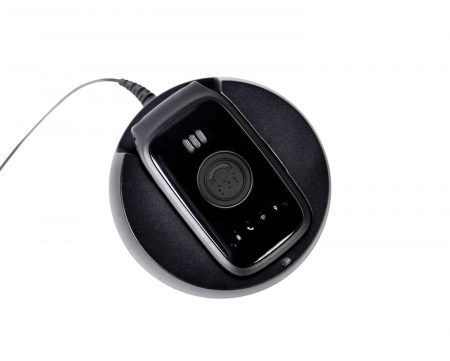
ResponseNow’s devices are monitored by several US-based centers. Upon signing up for ResponseNow, users will submit a list of contacts such as friends, family, or caregivers. When they call the monitoring center, they have the choice of having the center call their listed contacts or emergency services. If the operator cannot communicate with the user, they will automatically dispatch emergency services.
Extra Features
ResponseNow customers have several options for add-on features, including:
- Lockbox: Lockboxes ensure that emergency services will be able to enter users’ homes if they are unable to answer the door during the emergency. ResponseNow users can rent a lockbox for $3.95 a month.
- Care(+) Protection Plan: Users can add this protection plan to their service for an additional $3.95 a month. The plan covers any repairs from accidental damage or replacement of lost or stolen devices.
For more, read our full review of ResponseNow’s medical alert systems
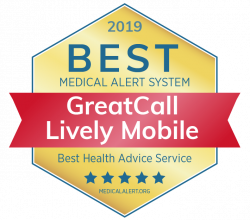
GreatCall Lively Mobile
Best for Health and Medical Information On-Demand
Two of the GreatCall Lively Mobile Health & Safety Packages include a feature called “Urgent Care.” With this feature, users can speak with a nurse or doctor at any time for medical advice or answers to their questions. The nurse or doctor can even send some prescriptions to the user’s pharmacy over the phone. This feature can save GreatCall Lively Mobile customers trips to urgent care or the doctor’s office and clear up any questions they have quickly and easily.
Pricing and Plans
GreatCall requires that customers purchase their devices, rather than rent the equipment. The Lively Mobile device costs $49.99, and then users choose between three service plans, referred to as Health & Safety Packages, which range in price from $24.99 to $39.99 a month. In 2019, GreatCall released an upgraded version of its device, now referred to as the Lively Mobile Plus. The LivelyMobile Plus offers some enhanced features, but the price remains unchanged.
In addition to the purchase cost, users must pay a $35 activation fee, and a $10 shipping fee. There is a 30-day trial period during which customers can return their device for a full refund (including the purchase and activation fees), but a $10 restocking fee is charged. Users can cancel their service at any time, and will receive a prorated refund for any prepaid months of monitoring service.
| Basic | Preferred | Ultimate | |
| Monthly Cost | $24.99 | $29.99 | $39.99 |
| One-time fees | $49.99 purchase, $35 activation | $49.99 purchase, $35 activation | $49.99 purchase, $35 activation |
| Type of Device | Mobile | Mobile | Mobile |
| Connection | Cellular | Cellular | Cellular |
| Battery Life | 24 hours | 24 hours | 24 hours |
| Water Resistant | Yes | Yes | Yes |
| Shower-proof | Yes | Yes | Yes |
| Range | Unlimited | Unlimited | Unlimited |
| Fall Detection | Not Available | Not Available | Included in Monthly Cost |
Device Features
GreatCall’s portable medical alert device, the Lively Mobile, is an all-in-one device that uses Verizon’s cellular network, so it works anywhere with cellular service. It also has GPS location services which help emergency services locate a caller during an emergency. The device is waterproof and can be worn in the shower or bath, and has a battery life of 24 hours between charges.
All customers must purchase a Lively Mobile for $49.99, then select a service plan.
Basic Plan
Read MorePreferred Plan
Read MoreUltimate Plan
Read MoreMonitoring
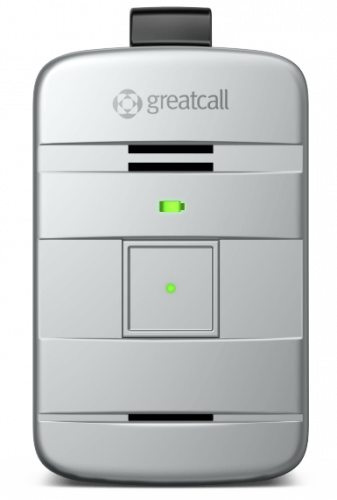
All emergency calls made on the GreatCall Lively Mobile connect with the IAED-certified 5Star Urgent Response Service center. Operators have access to users’ Personal Profile including their medical history and emergency contacts, and their location through the GPS in the device so they can quickly send emergency services when necessary.
Extra Features
There are no accessories for customers to purchase. But, if they choose certain Health & Safety Packages they will have access to extra features including:
- Urgent Care: Urgent Care is a 24/7 service that allows customers to get in touch with a registered nurse or doctor using their Lively Mobile device. They can ask medical and health-related questions, seek advice, or have prescriptions sent to their pharmacy. Urgent Care is included with Preferred and Ultimate plans.
- GreatCall Link: GreatCall Link is a mobile app that caregivers can use to view the user’s activity. The app shows a user’s call history with the monitoring center, as well as the battery life of their device. The feature is included with Preferred and Ultimate plans.
- Device Replacement: This gives users replacement coverage for broken, damaged, lost, or stolen devices. It is included with the Ultimate plan, and can be added to the other plans for $3 a month.
For more, read our full review of GreatCall’s medical alert systems
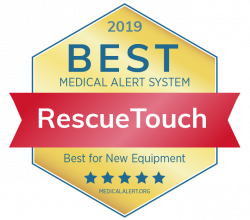
RescueTouch
Best for New Equipment
Most medical alert companies lease you equipment, and require that you return the equipment when you end your service. There is no way to know how old the equipment is, or how many people have previously used it. RescueTouch is different. Users actually purchase their devices, so it is guaranteed to always be new. It also saves users time after they cancel their service, as they do not have to send the equipment back or risk paying a huge fine if they forget or are unable to return the equipment during the given time frame.
RescueTouch recently merged with NurseAlert, a medical alert system for healthcare providers, to create Florida Health Alert and Technology. Its personal medical alert device is still available for individuals to purchase for themselves or their loved one.
Pricing and Fees
RescueTouch devices range in price from $30 to $75 a month. There is also a device purchase fee of $99 for single devices and $178 for twin packs. Customers may choose to pay for their device on a monthly, quarterly, or annual basis, but no matter which one they choose there are no long-term contracts. The quarterly and annual plans save users a few dollars a month compared to the monthly plan.
Other than the cost of purchasing the device, there are no other startup costs, and shipping is included with all plans. There is a 30-day money back guarantee for all new customers, and users can cancel their service at any time without paying a penalty.
RescueTouch also offers discounts on all of its devices for AARP members, veterans, nurses, first responders, and those with disabilities.
| 9-1-1 Direct | Family Response |
Family Response with Fall Detect |
The Whole Shabang |
Chit Chat Twin Pack |
Chit Chat Monitored Twin Pack | |
| Monthly Cost | $30 | $35 | $40 | $50 | $65 | $75 |
| One-time fees | $99 | $99 | $99 | $99 | $178 | $178 |
| Type of Device | Mobile | Mobile | Mobile | Mobile | Mobile | Mobile |
| Connection | Cellular | Cellular | Cellular | Cellular | Cellular | Cellular |
| Battery Life | 5 days | 2.5 days (5 days with GPS off) | 2.5 days (5 days with GPS off) | 2.5 days (5 days with GPS off) | 2.5 days (5 days with GPS off) | 2.5 days (5 days with GPS off) |
| Water Resistant | Yes | Yes | Yes | Yes | Yes | Yes |
| Shower-proof | Yes | Yes | Yes | Yes | Yes | Yes |
| Range | N/A | N/A | N/A | N/A | N/A | N/A |
| Fall Detection | Not available | Not available | Included in monthly cost | Included in monthly cost | Included in monthly cost | Included in monthly cost |
Device Features
RescueTouch only offers one device, the mobile SOS pendant. Rather than having a choice of device, RescueTouch customers choose one of six service plans, and the device is programmed accordingly before being shipped to the customer. The mobile SOS pendant is waterproof and has a two-way speaker, and is one of the only devices on the market to allow for two-way calling capabilities. This means that users’ pre-programmed contacts can actually call them via the device- each pendant is given a phone number, like a cell phone.
RescueTouch offers both monitored and unmonitored plans. “Unmonitored” means that when a user presses their emergency help button, they will connect with a preprogrammed list of friends and family rather than an emergency monitoring center.
9-1-1 Direct
Read MoreFamily Response
Read MoreFamily Response with Fall Detection
Read MoreChit Chat Twin Pack
Read More"The Whole Shabang"
Read MoreChit Chat Monitored Twin Pack
Read MoreMonitoring
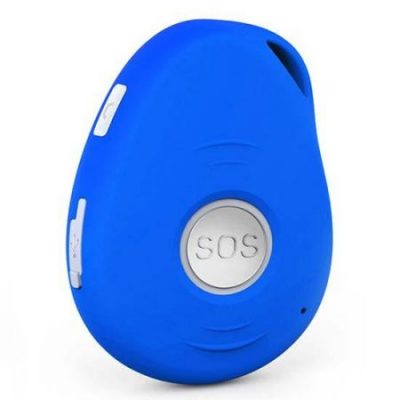
RescueTouch uses a US-based monitoring center located in Utah. All operators must undergo a training program to handle medical emergency situations, as well as fire and security emergencies.
Extra Features
RescueTouch does not offer any extra features at this time. The mobile SOS pendant is an all-in-one device, and “extra” features such as location services are included in the monthly cost of some plans.
For more, read our full review of Rescue Touch’s medical alert systems
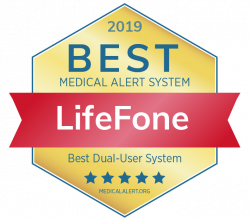
LifeFone
Best for Dual-User System
LifeFone allows users to add a second person to their service plan for no additional fee. This is ideal for spouses or other family members who live in the same home who both want protection, and makes medical alert systems much more affordable for two people living in the same household. Compared to paying for two separate monitoring plan, LifeFone can save couples or roommates hundreds of dollars per year.
Pricing and Plans
LifeFone’s four devices range in price from $29.95 to $43.95, and all may be paid for on a monthly, quarterly, or annual basis. The quarterly and annual plans are slightly less expensive than the monthly plan when broken down month-to-month. There are no activation, installation, or equipment fees, and shipping is included for customers who choose quarterly or annual payment options. Those who choose month-to-month payment pay $14.95 for shipping.
All LifeFone systems come with a 30-day free trial, during which customers can return their device for a full refund. Outside of the trial period, customers may cancel their service at any time and will receive a prorated refund for any prepaid months.
| At-Home | At-Home Cellular | At-Home & On-the-Go GPS | At Home & On-the-Go GPS, Voice-in-Necklace | |
| Monthly Cost | $29.95 | $34.95 | $39.95 | $43.95 |
| One-time fees | N/A | N/A | N/A | N/A |
| Type of Device | In-home system | In-home system | In-home and mobile system | Mobile system |
| Connection | Landline | Cellular | Cellular | Cellular |
| Battery Life | 32-hour backup | 32-hour backup | 24 hours; 30-hour backup | 36 hours |
| Water Resistant | Yes | Yes | Yes | Yes |
| Shower-proof | Yes | Yes | Yes | Yes |
| Range | 1,300 feet | 1,300 feet | 600 feet in-home, 350 feet mobile | N/A |
| Fall Detection | $5 a month | $5 a month | $10 a month | $5 a month |
At-Home Landline
Read MoreAt-Home Cellular
Read MoreAt-Home & On-the-Go GPS
Read MoreAt-Home & On-the-Go GPS, Voice-in-Necklace
Read MoreMonitoring
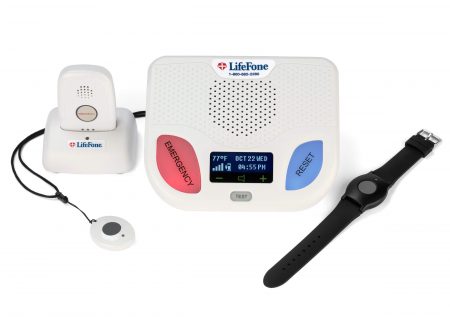
LifeFone operates its own call center in New York, with backup monitoring centers in New York and California. LifeFone customers set their own Emergency Care Instructions, so operators can follow this plan when a user calls for assistance.
Extra Features
LifeFone has a smartphone app, Mobile Alert, that customers can use to contact the monitoring center if they are not wearing their device or if they prefer to use their smartphone. In addition to using the app to contact the monitoring center during an emergency, customers can use it as a “virtual escort service” if they ever feel unsafe. Existing LifeFone users can download the app for $5.95 a month, and non-LifeFone customers can use the app for $7.95 a month.
Other features and accessories available for LifeFone customers include:
- Lockbox: LifeFone offers three different styles of lockboxes for customers to purchase. A hanging Master Lockbox and wall-mounted Master Lock Box are both available for $39.95, and a basic hanging lockbox is available for $29.95.
- Wall-Mounted Button: Customers can add a wall-mounted button to their home for extra protection in high-risk areas. The buttons can be purchased for $39.95 each.
- Activity Assurance: This feature is designed to give caregivers, friends, and family members of LifeFone users peace of mind about their loved one. At a set time each day, a beeping alarm will go off on the base station until the user presses a button. If the user does not press the button within 15 minutes, their emergency care plan is put into place. This feature is only available with in-home devices, and costs $6 a month.
- Vanity Pendants: LifeFone now offers upgraded “vanity pendants,” compatible with either of its two in-home systems. These pendants feature metallic hardware to look like standard jewelry, yet maintain all of the functions of a standard pendant-style personal help button. Vanity pendants may be purchased from LifeFone for a one-time fee of $89.00.
For more, read our full review of LifeFone’s medical alert systems
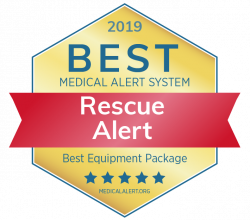
Rescue Alert
Best for Included Optional Devices
While some companies offer free accessories for annual or quarterly subscribers, it is rare that all payment plans- including month-to-month plans- include accessories. All Rescue Alert customers receive either a lockbox or second personal help button free of charge, regardless of which payment option they choose. This saves users several dollars a month, which can greatly help reduce overall yearly medical expenses.
Pricing and Plans
Rescue Alert devices range in price from $32.95 to $44.95 a month. All of the devices may be paid for on a monthly, quarterly, or annual basis, and the longer payment periods are slightly less expensive when broken down on a month-to-month basis. Additionally, LifeFone offers a unique purchase option for its in-home system. There are no device, activation, or installation fees for any of the devices, and shipping is included with all plans.
All customers are eligible for a 30-day trial at the start of their service, during which they may return their device for a full refund. Outside of the 30-day window, customers may cancel their service at any time without paying a penalty.
| MXD | Rescue Alert GPS | |
| Monthly Cost | $32.95 | $44.95 |
| One-time fees | N/A | N/A |
| Type of Device | In-home | Mobile |
| Connection | Landline | Cellular |
| Battery Life | 80-hour backup | 48+ hours |
| Water Resistant | Yes | Yes |
| Shower-proof | Yes | Yes |
| Range | 600 feet | N/A |
| Fall Detection | $10 a month | Not available |
MXD
Read MoreRescue Alert GPS
Read MoreMonitoring
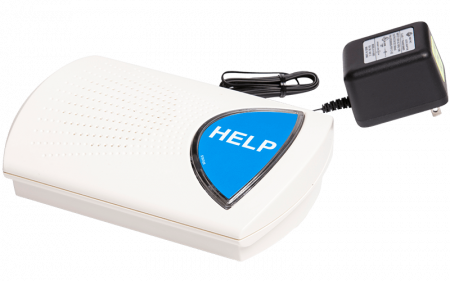
Rescue Alert has two Response Centers, both located in Utah. Both of the centers are certified by ETL.
Extra Features
All customers receive a free accessory with their device. If they would like additional accessories, their options include:
- myActive Alert Fall Detection: This is a fall detection pendant equipped with motion-sensing technology. It automatically triggers a call to the monitoring center if it senses a fall or abnormal movement. It is a separate pendant that users must wear in addition to their personal help button. The water-resistant device costs an additional $10 a month, and is only compatible with the in-home MXD system.
- Wall Button: This standalone button, designed for use with the in-home MXD system, can be placed anywhere in the home where users would like a bit of extra protection. The button has a range of 600 feet from the base station, and costs an extra $5 a month.
- Lockbox: Lockboxes provide emergency personnel with an easy way to enter users’ homes during an emergency if the caller is unable to answer the door. All Rescue Alert customers have the option of receiving a free rental lockbox with their device, or they can purchase a lockbox for $39.99.
For more, read our full review of Rescue Alert’s medical alert systems
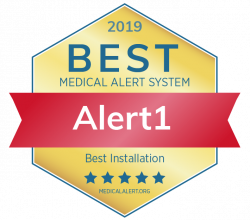
Alert1
Best for Easy Installation
Alert1 ensures that all seniors, regardless of their tech-savviness, will be able to set up their medical alert system without any stress. All Alert1 devices are preprogrammed prior to being shipped to customers, and when the system arrives, customers simply need to plug it in. That means no professional installation is required, and no installation fee. If customers do decide that they need help, they can simply call Alert1 customer support for assistance.
Pricing and Plans
Alert1 customers may choose to pay for their devices monthly, quarterly, annually, or for periods of 36 months. The devices range in price from $28.95 to $61.95 when paid for on a monthly basis, and all of the longer payment periods offer discounts on the month-to-month rate. Alert1 also offers a 30 day trial period for new customers, during which users can return their device for a refund. Customers may cancel their service at any time without paying a penalty.
Alert1 does not charge any one-time fees such as activation or installation fees, and free shipping is included with all devices.
| Home | Home Fall Detection | On-the-Go | On-the-Go Fall Detection | On-the-Go + Home Fall Detection | |
| Monthly Cost | $28.95 | $39.95 | $45.95 | $55.95 | $61.95 |
| One-time fees | N/A | N/A | N/A | N/A | N/A |
| Type of Device | In-home system | In-home system | Mobile system | Mobile system | Mobile system |
| Connection | Landline | Landline or cellular | Cellular | Cellular | Cellular |
| Battery Life | 24-hour backup | 24-hour backup | 30 days | 5 days | 24 hours |
| Water Resistant | Yes | Yes | Yes | Yes | Yes |
| Shower-proof | Yes | Yes | Yes | Yes | Yes |
| Range | 600 feet | 400 feet | N/A | N/A | N/A |
| Fall Detection | Not available | Included in monthly cost | Not available | Included in monthly cost | Included in monthly cost |
Home Medical Alert
Read MoreHome Fall Detection Medical Alert
Read MoreOn-the-Go Medical Alert
Read MoreOn-the-Go Fall Detection
Read MoreOn-the-Go + Home Fall Detection
Read MoreMonitoring
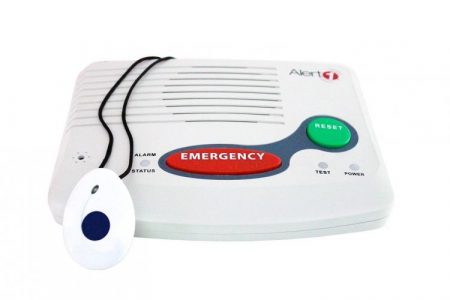
Alert1 operates its own US-based Command Center. The center is UL-listed and undergoes random certification checks. All operators must complete a thorough training program certified by The Monitoring Association. An interpreter service is available at all times to provide support in 190 languages.
Extra Features
Alert1 offers several extra features and accessories, including:
- Lockbox: Lockboxes are included with annual subscriptions. Other customers can purchase a lockbox for $39.95
- Wall-Mounted Emergency Button: Customers who want extra protection in high-risk areas in their homes can purchase a wall-mounted emergency button for $39.95. The wall-mounted buttons are only compatible with the in-home systems, not the mobile devices.
- Automatic Medication Dispenser and Organizer: The automatic medication dispenser and organizer helps users adhere to their medication regimens. The device can be programmed for up to 4 medication reminders per day, and includes a locked dispenser for extra safety. At the preprogrammed times, an alarm will sound and will continue until the pills are removed from the dispenser. This accessory can be purchased for $149.95.
- Voice Extender: The Alert1 voice extender improves the range of devices in the home, and can be a good idea for those who live in larger homes and worry about their voice carrying to the base station. This device is compatible with the Home and Home Fall Detection systems, and can be purchased for $99.
For more, read our full review of Alert1’s medical alert systems
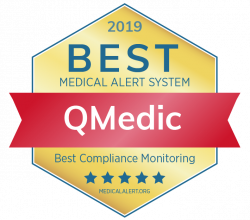
QMedic
Best for Forgetful Seniors
All QMedic devices come equipped with a unique compliance monitoring feature which detects whether the user is actually wearing their device. This information is uploaded to the Caregiver Dashboard so caregivers and family members of the user can make sure their loved one is using the device – this is especially useful for seniors who often forget to wear their devices. Loved ones can also use the Caregiver Dashboard to view activity monitoring data such as their loved one’s sleep patterns and activity levels.
Pricing and Plans
QMedic offers three devices, all of which can be paid for monthly or annually. The two in-home devices cost $30 a month, and the mobile device costs $45 a month. Those who choose the annual plan ultimately save $60 per year for an in-home device, and $140 per year for the mobile device.
QMedic does not charge equipment, activation, or shipping fees within the United States (those outside of the U.S. may have to pay for shipping). Customers may cancel their rental at any time, and there is an initial 30-day money back trial period on all systems.
| Landline | Cellular | Mobile GPS | |
| Monthly Cost | $30.00 | $30.00 | $45.00 |
| One-time Fees | N/A | N/A | N/A |
| Type of Device | In-home | In-home | Mobile |
| Connection | Landline | Cellular | Cellular |
| Battery Life | 24-hour backup | 24-hour backup | 14 days |
| Water Resistant | Yes | Yes | Yes |
| Shower-proof | Yes | Yes | No |
| Range | 800-1,000 feet | 800-1,000 feet | N/A |
| Fall Detection | Not available | Not available | Not available |
Landline
Read MoreCellular
Read MoreMobile GPS
Read MoreMonitoring
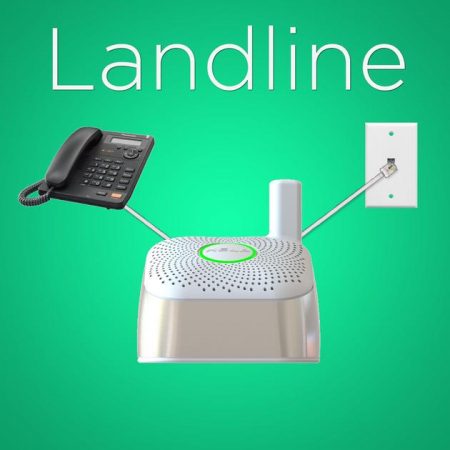
The QMedic monitoring center is UL-listed and US-based. There are two branches, one in Utah and one in Idaho.
Extra Features
In addition to compliance and activity monitoring, which are both included free of cost with all QMedic devices, QMedic systems include free access to the Caregiver Dashboard. All activity and compliance monitoring data is uploaded onto the dashboard, so family, friends, and caregivers can check if their loved one is wearing the device or if they are showing any unusual behavioral patterns. They can also see their loved one’s call history with the monitoring center. QMedic does not offer any additional accessories at this time.
For more, read our full review of QMedic’s medical alert systems
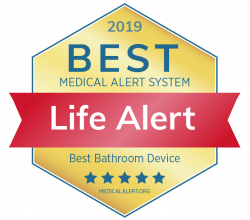
Life Alert
Best for Protection in the Bathroom
Life Alert offers an “In the Bathroom” device, a wall-mounted button specifically designed for use around water. The device is completely waterproof so it can be placed directly in the bathtub or shower, two of the most high-risk areas for seniors. It also features both a speaker and a microphone so, during an emergency, users can communicate with the monitoring center directly through the In the Bathroom device. In addition to this wall-mounted system, Life Alert offers standard in-home and mobile devices.
Pricing and Plans
Life Alert’s three devices are referred to as three levels of protection: In the Home, In the Bath, or On the Go. The three tiers may also be thought of as packages; for instance, one cannot sign up for monitoring with the In the Bath device without In the Home, or On the Go without the other two devices.
The pricing is tiered:
- The first tier is just In the Home, and costs $49 a month plus a comprehensive one-time fee of $95
- The second tier is In the Home and In the Bath, and costs $69 a month plus a comprehensive one-time fee of $96
- The third tier is all three devices, and costs $89 a month plus a comprehensive one-time fee of $198
Life Alert requires users to sign a 3-year service contract. The contract may only be broken for “qualifying circumstances”, such as moving into a nursing home. If a customer chooses to end their contract without a qualifying reason, they may be responsible for paying for the remaining months of the contract.
| In the Home | In the Bathroom | On the Go | |
| Monthly Cost | $49 | $69 | $89 |
| One-time Fees | $95 | $96 | $198 |
| Type of Device | In-home | In-home | Mobile |
| Connection | Landline/Cellular | Landline/Cellular | Cellular |
| Battery Life | 72-hour backup | 72-hour backup | Up to 10 years |
| Water Resistant | Yes | Yes | Yes |
| Shower-proof | Yes | Yes | Yes |
| Range | 800 feet | 800 feet | N/A |
| Fall Detection | Not available | Not available | Not available |
Device Features
Life Alert manufacturers its own equipment, and all of the systems come with a lifetime warranty. Fall detection is not available with any of the systems.
In the Home
Read MoreIn the Bathroom
Read MoreOn the Go
Read MoreMonitoring
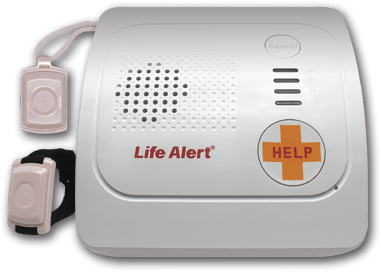
Life Alert operates their own US-based, UL-listed monitoring center. All dispatchers spend up to one year in training, and keep all Life Alert users’ medical history on file to give to paramedics during an emergency. They also notify users’ family members when their loved one places an emergency call.
Extra Features
Life Alert offers a mobile app that users can download to their smartphone. Customers can use the app to contact the monitoring center if they are not wearing their device or find it easier to use their phone rather than their personal help button. In addition to emergency assistance, users can use the app to contact the monitoring center if they simply feel unsafe and want to have an operator on the line. Life Alert users without a smartphone have the option of dialing the monitoring center on a normal cell phone.
For more, read our full review of Life Alert’s medical alert systems
More Medical Alert System Reviews
For more about other medical alert system brands we’ve reviewed and to see head to head comparisons, click on the links below.
Additional Medical Alert Reviews
- Apple Watch Medical Alert
- One Call Alert Review
- Medipendant Review
- Vri Review
- Medical Care Alert Review
- Ats Review
- Rescue Alert Review
- Rescuetouch Review
- Adt Review
- Medical Alert Review
- Brick House Review
- Numactive Review
Head to Head Comparisons
- Life Alert vs Bay Alarm Medical
- Life Alert vs Philips Lifeline
- Greatcall vs Life Alert
- Mobilehelp vs Life Alert
- Life Alert vs Adt
- Alert1 vs Life Alert
- Life Alert vs Medical Alert
- Lifestation vs Life Alert
- Medical Guardian vs Life Alert
- Medical Guardian vs Bay Alarm Medical
- Bay Alarm Medical vs Greatcall
- Mobilehelp vs Bay Alarm Medical
- Mobilehelp vs Greatcall
- Mobilehelp vs Medical Guardian
Understanding Medical Alert Systems
Medical alert systems provide seniors with the assistance they need after an accident, injury, or another medical emergency. They make it easy for users to access emergency services quickly, and help make the process as simple as possible. Those looking into purchasing a medical alert system generally have two choices: in-home systems or mobile units.
In the Home
In-home systems always include a base station that remains stationary somewhere in the home and connects to the emergency monitoring center. It has a loudspeaker and a highly sensitive microphone, so users can communicate with the monitoring center through the unit. Most base stations have a range of 600-1,300 feet, covering most areas of users’ homes. Some units must connect to a working landline, while others use cellular service.
In addition to the base station, in-home units include a wearable personal help button. These devices are small and can be worn around the neck or on a wristband. If a user needs emergency services, they press the button to trigger the base station to call the monitoring center. If the operator at the center is unable to communicate for the caller for whatever reason, they will automatically put the user’s emergency care plan in place, which may involve calling emergency services or the caller’s personal contacts.
On the Go
Mobile systems are small, portable devices that rely on cellular service to connect with the emergency monitoring center, so they work anywhere with a cellular connection. Some mobile systems are all-in-one devices with an emergency help button included, while others require users to carry two pieces. The two-piece systems usually include a pocket-sized device that functions as a portable base station, and a wearable personal help button. Unlike in-home units, mobile devices do need to be charged, usually every few days (though it is often recommended to place the device in its charging cradle each night).
In addition to emergency monitoring services, many of these devices have GPS location services so emergency personnel or loved ones of the user can easily locate the caller during an emergency. These services are usually included in the system’s monthly cost.
Who Should Consider a Medical Alert System
It is a common misconception that medical alert systems are only designed for seniors who are prone to falls. In addition to providing emergency support for these individuals, modern medical alert systems have many other uses. Read on for more information about who may benefit from a medical alert device.
Active Seniors
A 2017 study shows that 48% of falls happen outdoors, which can be worrisome for active seniors who spend a lot of time outside. A portable medical alert system can help these adults maintain the freedom to enjoy the outdoors as long as possible, without causing themselves or their loved ones anxiety over being without help if a fall or other accident happens while they are outside.
Independent and active seniors looking into a medical alert device should look for the following features:
| Mobile Device | If you or your loved one is active, a mobile device is the way to go. It will work anywhere with cellular service, so seniors can travel or spend time outside of the home without worry. |
| Upgraded Location Tracking | Some devices have upgraded location tracking that uses a combination of cellular signals, WiFi, and GPS to locate callers, rather than just relying on cellular service. These devices are much more precise, and make it easier for emergency personnel to locate users. |
| Wearable Help Button | For active seniors, a two-piece system with a small wearable help button will likely be more comfortable. These wearable components are small, light, and can be worn around the neck, as opposed to all-in-one systems which tend to be a bit bulkier. |
| Extended Battery Life | If you plan to be out-and-about often, look for a portable device with sufficient battery life for your active lifestyle. Make sure that your device has a long enough battery life to get you through your day’s adventures without needing to take a break to charge. Some top devices have batteries that can maintain their power for more than 24 hours between charges. |
Aging in Place
More and more seniors are choosing to age in place – 75% of older adults plan to live in their current home for the rest of their lives. But, living independently without a caregiver puts seniors at risk of not receiving the care they need after a medical emergency or fall. If a fall does occur, emergency care may be necessary. An older adult is treated for a fall in an emergency room every 11 seconds, and 25% of older adults experience a fall once a year.
Medical alert systems help seniors with mobility issues or those who receive in-home care age in place while still having easy access to emergency services when needed. The systems are especially useful for older adults who do not have a caregiver or loved one with them in the home around-the-clock.
Older adults who have mobility issues or receive in-home care should look for the following features in a medical alert system:
| Reasonable Monthly Monitoring Costs | Seniors who age in place often already have hefty expenses for in-home care, and certainly do not need to add another pricey service to their monthly costs. Those who find themselves in this situation should compare multiple companies before signing up for service, so they can find one that offers the service they need at a reasonable price. Companies like Bay Alarm Medical and MobileHelp offer affordable options so seniors do not need to push their budget to get the protection they need. |
| Fall Detection | Seniors who struggle with mobility are at a higher risk of falls than other older adults, and can benefit from automatic fall detection. This feature may raise the price of the medical alert system a bit, but provides extra protection for at-risk seniors. While the systems are not 100% reliable, they can be a great help for those who are prone to falls. |
| Voice Activated Wall Button | This feature makes it even easier for seniors to contact the monitoring center during an emergency. If they need assistance, they can simply say an activating phrase to trigger a call to the monitoring center- they do not even need to press their personal help button. Currently, this feature is only offered by Medical Guardian, but it may be offered by more companies in the future. |
| Automated Medication Reminders and Dispensers | These devices can provide alerts when it is time to take medication, and sometimes even automatically dispense the dose for the user. This helps prevent seniors who age in place from forgetting to take their medication or taking the wrong one, since they do not have medication assistance like they would in a residential care facility. Philips Lifeline offers an automated medication dispenser, and other companies like MobileHelp will provide medication alerts for users. |
Seniors with Memory Impairment
Wandering is a serious problem for older adults with memory impairment – 60% of those with dementia will wander, and someone with Alzheimer’s is likely to be unable to recall information like their name and address. Medical alert devices help caregivers or family members or seniors with dementia find their loved ones if they do wander and become lost.
The following medical alert system features are particularly beneficial for seniors who have dementia:
| Mobile and Home Device Bundle | Seniors who are prone to wandering should definitely look for a mobile device with location services so their loved ones can locate them if they become lost. But, they may also benefit from a device that does not need to be charged. These units tend to be in-home systems. To avoid having to pay for two systems, look for a bundle package with both a portable, GPS-enabled device as well as an in-home system. MobileHelp offers one of these combination plans for $41.95 a month. |
| Pinpoint Location Tracking | Some mobile systems have upgraded location services that use a combination of cellular signal, WiFi hotspots, and GPS to locate users. These systems are much more reliable than older location tracking services, which only used cellular signal. The newer options can quickly locate a user’s exact location, helping them reconnect with their loved ones or access the care they need. |
| Caregiver App | Some medical alert systems include access to a mobile app for caregivers of the user. Using the app, caregivers can check their loved one’s device’s battery level and remind them if it needs charging, receive notifications if their loved one falls or places a call to the monitoring center, and more. Some apps even allow caregivers to place a call directly to their loved one’s medical alert device and check their loved one’s movement and activity levels. All of these features can make caring for a senior with dementia easier and provide peace of mind for loved ones of seniors with dementia. |
| Geofencing | This feature allows family members or caregivers of a user to set geofencing alerts (usually a text message or email) when their loved one moves outside of a predetermined area. This lets them know that their loved one may be wandering, and can help prevent seniors from getting lost. Bay Alarm Medical currently offers this feature. |
| Wall Buttons | Wall buttons provide extra protection in high-risk areas around the home, such as the bathroom, or serve as a backup if you or your loved one forgets to wear their personal help button. |
| Medication Reminders | This service, offered by several companies such as MobileHelp, sends automated reminders to help seniors adhere to their medication schedule. |
Seniors with Chronic or High-Risk Medical Conditions
Older adults with diabetes face severe health risks. Almost 70% of seniors with the condition will die due to some type of heart disease, and approximately 1 in 6 will die due to a stroke. Many of these deaths may potentially be prevented if the senior had access to the medical care they needed in time. Medical alert systems can help seniors in these situations, and be lifesaving for older adults with chronic, high-risk conditions like diabetes or heart disease. Older adults with high-risk conditions should look for the following features, which provide extra protection:
| Activity Monitoring | This feature uses motion-sensing technology to monitor and detect changes in users’ activity levels, or a lack of activity. If abnormal movement or lack of movement is detected, the company alerts a loved one that something may be wrong. Medical Guardian and several other companies offer this feature. |
| Fall Detection | Automatic fall detection provides extra protection for seniors who are at high risk of falling or having a medical emergency. Though not 100% reliable, the systems can be lifesaving if a user is unable to press their personal help button during an emergency situation. |
| Voice-Activated Button | In some serious cases, one may be unable to physically press their wearable help button during a medical emergency. Having a voice-activated alert button in the home can be critical during these situations. Seniors can simply repeat a phrase, such as “emergency” several times to trigger a call and alert to the emergency monitoring center and/or the user’s caregivers, ensuring they can get the help they need even if they’re unable to physically move. |
Guide to Additional Features
Modern medical alert systems can do much more than just contact an emergency monitoring center. The systems often come equipped with a variety of additional features designed to benefit seniors. Sometimes these features are included in the monthly cost, and sometimes customers must pay an extra fee.
Fall Detection
This newer feature automatically detects when a user falls down, and triggers an alert to the emergency monitoring center. It can be lifesaving in situations when the user is unable to press their personal help button and helps them get the help they need as quickly as possible. As a newer technology, fall detection is not 100% reliable, but it does provide some added protection for those who are prone to falls. It is typically an add-on feature that costs an extra $5-10 dollars a month.
Caregiver Tracking and Monitoring
Caregiver tracking and monitoring help caregivers and family members of a medical alert system user monitor their loved one’s activity levels and location. It is typically used with mobile devices, and uses a smartphone app or online website where caregivers can log in to check to device’s location, battery levels, or the user’s activity levels. Geofencing, which sends a text message to caregivers if their loved one goes outside of a predetermined area, is another popular aspect of caregiver monitoring.
Medication Dispensers and Reminders
This feature is designed to help seniors who have complicated medication regimens, struggle to stick to their schedule, or have a hard time remembering whether they have taken their medication or sometimes mistakenly take the wrong one or dosage. The automatic reminders send an alert to the senior when it is time to take their medication. The automatic dispenser is a separate device that releases the correct medication for the user, at the right time and right dose.
Wall Buttons
Wall-mounted buttons can be placed anywhere in the home for extra protection. They are typically placed in high-risk areas, such as the bathroom, where a senior is most likely to fall. They can come in handy if the user is not wearing their personal help button, or just may be easier for them to use. The wall-mounted button triggers a call to the monitoring center in the same way that the wearable personal help button does.
Voice Extender
In-home devices have a limited range that does not always reach a user’s yard or throughout an entire large home. A voice extender is a good option for those who do not want a mobile device, but have areas of their home where the in-home device cannot reach on its own. For example, someone could install a voice extender on the outside of their home so they can communicate with an operator from their backyard. It also helps prevent accidental calls to EMS if you press your personal help button but cannot hear the base station to cancel the call.
Fire, Smoke, Carbon Monoxide, and Water Monitoring
These devices can be placed in the home and send an alert to the emergency monitoring center if it detects fire, carbon monoxide, or water leaks.
How to Choose a Medical Alert System
Determine Which Type of System is Best for You
Once you decide to purchase a medical alert system for yourself for a loved one, you need to think about which type of device you need. The biggest decision is whether an in-home or mobile system is better for you. Some companies also offer a bundle plan that includes both types of devices. An increasing number of companies are also beginning to offer smartwatch-style devices, which offer emergency monitoring as well as typical smartwatch features.
The main factor that will influence your decision is where you or your loved one spends most of their time. More active seniors benefit from mobile devices, which offer protection on-the-go, while those who spend most of their time at home may be better off with in-home devices that focus on protection in the household and do not require regular charging.
Compare Different Companies
When beginning your search, you’ll find that there are dozens of medical alert companies for you to choose from. But, not all products and services are equal. It is important to find a quality company and avoid those that charge high fees for sub-par devices, or those that lack reliable customer service. This guide is a great place to start, but be sure to do further research to make sure a company offers devices and services that meet your needs before signing on with them. You’ll also want to ask yourself the following questions:
Is the company upfront about their pricing, fees, and policies?
Look for companies that are upfront and clear about their pricing and subscription plans, extra fees like shipping or activation, and return policies. Companies that provide this information in clear detail on their website or over an initial phone call generally are more honest and will be easier to work with. Those that do not provide this information upfront, do not provide detail, have confusing pricing structures, or make you feel like you are pulling teeth to get the information are most likely shady and will not provide you with quality services at a fair price.
Are you able to cancel your service at any time?
Be sure to look for a company with a clear and reasonable cancellation and return policy. You should be able to end your service at any time without facing extra charges- some companies even offer a prorated refund for any prepaid months. Many modern companies offer service without a long-term contract, so avoid getting roped into one and look for companies with more consumer-friendly policies. Other than return shipping, you should not have to pay any fees for canceling your service.
Look for Devices That are Comfortable and Convenient
In addition to finding an honest and reliable company, it is important to look for devices that are comfortable and convenient. Medical alert systems are essentially useless if the customer does not wear the device. To ensure that your loved one actually wears the device and gets the protection they need, look for devices that will not interfere with their daily activities or cause them discomfort.
Most home systems come with a lightweight pendant that you can either wear as a pendant around your neck or on a wristband. When purchasing a home system, you can generally expect for the wearable component to be comfortable and convenient. But if you are looking into a mobile system, you need to pay more attention to the specifics of the wearable device. While there are certainly small, comfortable options out there, other mobile devices are bulky and can be a nuisance to carry around. Look for a mobile device that can be worn on a belt clip or placed in a purse, and a small wearable component like those included with in-home systems.
Another aspect of convenience is battery life. In-home devices generally do not need to be charged, but mobile systems do. Battery life on these devices can vary from just one day to up to 30 days, so some require nightly charging. If you are concerned that you or your loved one will not remember to charge the device, look for a system with longer battery life or one with caregiver battery monitoring. This feature allows caregivers or family members of the user to check the battery life of their loved one’s device, and sends an alert to caregivers when the battery gets too low.
Think About Additional Features
Most companies offer optional, add-on features to their monitoring services. Some of the most helpful ones include lockboxes, automatic fall detection, caregiver tracking, and medication management tools. All of these additional features help make medical alert systems more well-rounded safety devices that can help seniors all the time, and not just during a critical emergency. The features you’ll need are dependent on you or your loved one’s specific needs. Read our above section “Who Should Consider a Medical Alert System” to learn more about which features can benefit you the most.
Choose a Payment Plan
Most companies offer customers several options for paying for their device: month-to-month payment, or a quarterly, semi-annual, or annual subscription. Oftentimes, the longer subscription plans offer a discount on monthly cost, as well as extra perks such as free shipping or free accessories.
The potential downside to choosing a subscription plan is the potential loss if you decide to cancel your service after prepaying for several months. Be sure to check the company’s cancellation policies to see if they offer a prorated refund for prepaid months after cancellation. And, if you plan on paying for several months or a year upfront, be sure to choose a trustworthy and reputable company.
Additional Resources
To learn more about choosing a medical alert system and what to look for based on your unique situation, read the helpful resource linked below.
- 5 Tips on Choosing A Medical Alert System Provider
- Most Affordable Medical Alert Systems
- Most Reliable Medical Alert Systems
- Best Smart Watch Medical Alert Systems
- Best Wall Mounted Medical Alert Systems
- Best Bracelet Medical Alert Systems
- Best Medical Alert Systems for Women
- Best Medical Alert Systems for Blind Seniors
- Best Cellular Medical Alert Systems
- Best Medical Alert Systems for Couples
- Consumer Reports Tips on Buying a Medical Alert
- Best Medical Alert Systems with Fall Detection
- Best Medical Alert Systems with GPS
- Best Medical Alert Systems with Speakers
- Best Medical Alert Systems for Men
- Best Home Medical Alert Systems
- Best Medical Alert Systems for Disabled Seniors
- Buying a Medical Alert System
- Consumer Reports Tips on Buying a Medical Alert
- The Best Medical Alert Apps
- The Best Voice Activated Medical Alerts
- Best Medical Alert Systems for Veterans
- Greatcall Review
- Life Alert Review
- Connect America Review
- Responselink Review
Medical Alert Systems Cost & Payment Assistance for Low-Income Seniors
Medical alert companies utilize different payment structures. Some charge an up-front fee to purchase the system, while others lease customers the actual equipment and only charge for monitoring services, with a rental fee built-in to that cost. How much you’ll pay depends on the company and its payment structure, the type of system you choose, as well as any extra features or services that come with an additional monthly fee. In-home systems tend to be less expensive and cost around $20-$30 a month, while mobile units are a bit pricier and usually range from $30-45 a month. Some systems can cost as much as $60 a month.
This may be out of reach for some low-income seniors, and private insurance and Medicare typically do not cover the cost of a medical alert system. However, there are some payment assistance options that you may be eligible for depending on your income, the state in which you reside, and your personal situation.
Free Systems for Veterans Through the VA
The VA has a program that provides veterans with a device that is very similar to a medical alert system, one of the numerous services designed to help elderly or disabled veterans maintain their independence.
Unlike most medical alert devices on the market, this system is not monitored by a professional emergency monitoring center. Rather, it connects with pre-programmed numbers, such as friends, family, or a caregiver. The main downside of this is that those contacts are not always at their phones or available to answer a call, so it is possible that a message could go hours without someone seeing it.
Still, if you cannot afford a medical alert system, this option is certainly better than nothing. Contact the VA at (844) 698-2311 or visit your local VA for more information about the program and how to apply.
Medicaid Assistance
Medicaid offers coverage of medical alert systems as Personal Emergency Response Services (PERS). PERS often qualifies as a service that seniors can use to retain their independence rather than move to a nursing home.
The amount of coverage, and if it is available at all, varies between different states. But, some assistance is available in most states, either through regular Medicaid or a waiver program.
Other State Assistance Programs
In addition to Medicaid assistance, most states offer some sort of non-Medicaid assistance to help seniors access and pay for medical services. The programs vary between different states, but most have some sort of assistance plan in place to help seniors access medical alert systems or find an alternative.
Insurance
Standard health insurance does not typically cover medical alert systems. But, long-term care insurance may cover the cost of a device. Long-term care insurance policies usually cover durable medical equipment and services or devices that help seniors retain independence rather than move to a residential care facility. Check your policy to see if you have coverage for durable medical equipment or other related services and costs.
Connect with Your Local Area Agency on Aging
Area Agencies on Aging (AAA) are located throughout the country, and provide various services and assistance to seniors. The organization does not directly provide assistance with paying for medical alert systems, but your local AAA can direct you to available programs in your state or city. They can also help you determine which assistance programs you may qualify for.
Frequently Asked Questions
What Are the Best Medical Alert Systems?
The best medical alert systems are reliable, durable, and affordable. The specific system that is best for you will depend on your personal needs, but you can read our above review of the best medical alert systems to learn about some top companies like MobileHelp, Bay Alarm Medical, and Medical Guardian.
What Do Medical Alert Systems Cost?
Medical alert systems typically cost approximately $20-$30 per month for an in-home system and $30-$45 a month for a mobile system. The cost will depend on the type of system, what features it has, the payment terms, and the company’s rates. It’s a good idea to compare costs prior to signing on with one company, because there can be quite a bit of variability in cost for similar systems from different companies.
Will Medicare Cover Medical Alert Systems?
Medicare typically does not cover medical alert systems. However, some Medicare Advantage plans may provide coverage for medical alert systems. Additionally, in many states Medicaid covers a portion or all of the cost of “Personal Emergency Response Services” (PERS), which include medical alert devices, for beneficiaries.
Who Should Get a Medical Alert System?
Older adults who live independently or in a community and want extra protection in the event of an emergency should get a medical alert system. Medical alert systems can be especially beneficial for seniors who live alone, have a history of falls, or live with a memory impairment or chronic condition that may require immediate medical attention. The devices make it extremely easy for users to get the help they need in an emergency.
Do I Need a Landline for a Medical Alert System?
No, you do not need a landline for a medical alert system. While certain in-home systems do require a landline to connect its in-home base to the emergency monitoring center, all medical alert companies offer alternatives, such as portable devices and in-home systems with cellular connection.
To learn more about medical alert systems and for answers to common questions, click on the links below.
- Where’s the Best Place to Buy Medical Alert Systems?
- Should I Choose a Pendant or Speaker Style Medical Alert System?
- Does Costco Sell Medical Alert Systems?
- Does Medicare Pay for Medical Alert Systems
- How Much Does a Medical Alert System Cost?
- Does Medicare Cover Medical Alert Systems
- How Do Medical Alert Systems Work
- Are Medical Alert Systems Tax-Deductible
- How To Order A Medical Alert Bracelet
- When Should You Get A Medical Alert Bracelet
- Does Tricare Cover Medical Alert Systems
- Does Va Pay For Medical Alert Systems
- Can You Get A Medical Alert Bracelet For Free?
- Does Aarp Cover Medical Alert Systems
- Does Walmart Sell Medical Alert System

